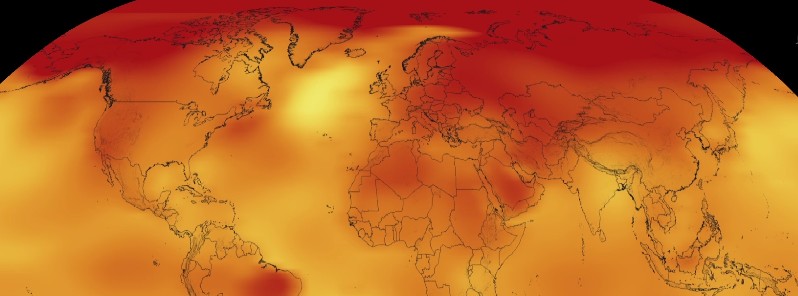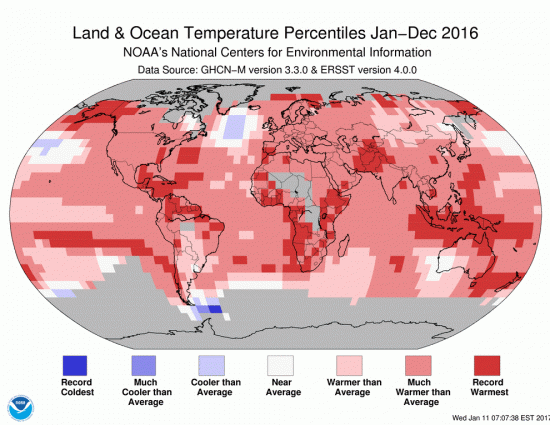WMO confirms 2016 hottest year on record

According to a consolidated analysis by the World Meteorological Organization (WMO), the year 2016 has been confirmed as the hottest year on record, surpassing the exceptionally high temperatures of 2015.
The globally averaged temperature in 2016 was about 1.1°C (2.0 °F) higher than the pre-industrial period. It was approximately 0.83 °C (1.49 °F) above the long term average (14°C / 25.2 °F) of the WMO 1961-1990 reference period, and about 0.07°C (0.12 °F) warmer than the previous record set in 2015.
“2016 is remarkably the third record year in a row in this series,” said NASA’s Goddard Institute for Space Studies (GISS) Director Gavin Schmidt. “We don’t expect record years every year, but the ongoing long-term warming trend is clear.”
"The change was driven largely by increased carbon dioxide and other human-made emissions into the atmosphere," NASA said. "Most of the warming occurred in the past 35 years, with 16 of the 17 warmest years on record occurring since 2001. Not only was 2016 the warmest year on record, but eight of the 12 months that make up the year – from January through September, with the exception of June – were the warmest on record for those respective months. October, November, and December of 2016 were the second warmest of those months on record – in all three cases, behind records set in 2015."

Phenomena such as El Niño or La Niña, which warm or cool the upper tropical Pacific Ocean and cause corresponding variations in global wind and weather patterns, contribute to short-term variations in global average temperature. A warming El Niño event was in effect for most of 2015 and the first third of 2016. Researchers estimate the direct impact of the natural El Niño warming in the tropical Pacific increased the annual global temperature anomaly for 2016 by 0.12 °C (0.21 °F).
Weather dynamics often affect regional temperatures, so not every region on Earth experienced record average temperatures last year. For example, both NASA and NOAA found the 2016 annual mean temperature for the contiguous 48 United States was the second warmest on record. In contrast, the Arctic experienced its warmest year ever, consistent with record low sea ice found in that region for most of the year.

NASA’s analyses incorporate surface temperature measurements from 6 300 weather stations, ship- and buoy-based observations of sea surface temperatures, and temperature measurements from Antarctic research stations. These raw measurements are analyzed using an algorithm that considers the varied spacing of temperature stations around the globe and urban heating effects that could skew the conclusions. The result of these calculations is an estimate of the global average temperature difference from a baseline period of 1951 to 1980.
The full 2016 surface temperature data set and the complete methodology used to make the temperature calculation are available at: http://data.giss.nasa.gov/gistemp
NOAA scientists used much of the same raw temperature data, but with a different baseline period, and different methods to analyze Earth’s polar regions and global temperatures.
WMO uses data from the US National Oceanic and Atmospheric Administration, NASA’s Goddard Institute for Space Studies and the UK’s Met Office Hadley Centre and the University of East Anglia’s Climatic Research Unit. WMO also draws on reanalysis data from the European Centre for Medium Range Weather Forecasts and the Copernicus Climate Change Service, which use a weather forecasting system to combine many sources of data to provide a more complete picture of global temperatures, including in Polar regions.
WMO’s final statement on the global climate in 2016, which includes full details of regional and national temperatures, extreme events, sea level rise and tropical cyclones, will be published in March 2017.
Featured image credit: NASA/Goddard

Commenting rules and guidelines
We value the thoughts and opinions of our readers and welcome healthy discussions on our website. In order to maintain a respectful and positive community, we ask that all commenters follow these rules.